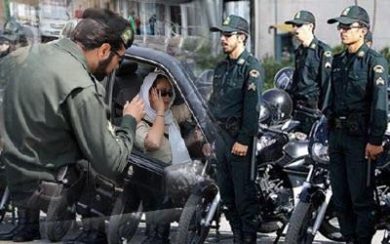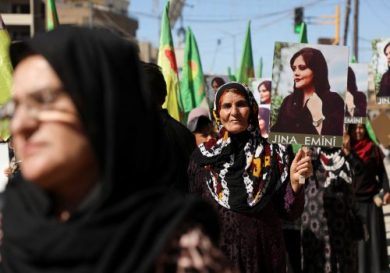In the streets of Tehran, a woman silently raises her hijab high above her head on the tip of a stick — a simple act, yet a revolutionary symbol. In recent years, especially since the death of Mahsa Amini in 2022 after being arrested for allegedly wearing her hijab “improperly,” Iranian women’s clothing choices have transformed from private matters into public protests. What women wear — and refuse to wear — has become a powerful form of resistance against the Islamic Republic’s deeply entrenched system of control, enforced primarily by the Islamic Revolutionary Guard Corps (IRGC) and its morality police.
The hijab, originally introduced as part of the regime’s ideological framework, has become a battleground for freedom, dignity, and bodily autonomy. This article explores how dress — particularly the hijab — has evolved into a political symbol, why women are risking their lives to defy it, and how the world is responding.
1. The Hijab: From Religious Symbol to State Tool
A. Post-Revolution Enforcement
Following the 1979 Islamic Revolution, the Iranian government mandated the compulsory hijab law, requiring all women and girls over the age of nine to cover their hair and dress modestly in public. The regime justified the rule as aligning with Islamic values, but it quickly became clear that the hijab was less about faith and more about control.
Women who resisted were labeled immoral, Westernized, or traitorous. The IRGC, alongside the Basij militia, took charge of enforcing hijab laws, surveilling, detaining, and punishing women who didn’t comply — often violently.
B. A Tool of Gender Oppression
The mandatory hijab is not just a dress code; it represents a system where women’s bodies are controlled by the state. The morality police (Gasht-e Ershad), often operating under IRGC influence, have long harassed and assaulted women in public spaces, instilling fear and suppressing freedom of expression.
For many Iranian women, the hijab has come to symbolize the broader gender apartheid in Iran — one enforced through law, religion, and state violence.
2. The Spark: Mahsa Amini and the Rise of “Women, Life, Freedom”
A. The Death That Ignited a Nation
In September 2022, 22-year-old Mahsa Amini died in the custody of the morality police after being arrested for allegedly wearing her hijab improperly. Her death sparked outrage and massive protests across the country — not just from women, but also from men, ethnic minorities, students, and workers.
The protest slogan “Zan, Zendegi, Azadi” (Women, Life, Freedom) spread like wildfire, becoming the rallying cry of a new civil rights movement.
B. Dress as Defiance
As protests grew, more women began publicly removing their hijabs, burning them, or waving them like flags — knowing full well they risked imprisonment, torture, or death. These acts transformed the hijab into a tool of resistance, a bold and visible rejection of the regime’s authority.
In defying hijab laws, women weren’t rejecting religion, but rather a state-imposed version of it that weaponized faith to maintain power.
3. The Role of the IRGC in Suppressing Dress-Based Resistance
A. Brutal Crackdowns
The IRGC responded with overwhelming force, arresting thousands and killing hundreds. Women who removed their hijabs during protests were subject to beatings, rape, forced confessions, and long prison sentences.
Some were sentenced under vague charges like:
• “Spreading corruption on earth”
• “Acting against national security”
• “Insulting Islamic sanctities”
B. Surveillance and Repression
In addition to physical crackdowns, the IRGC has employed advanced facial recognition technology, tracking women via public CCTV footage to identify and punish those who appear without a hijab.
Social media accounts sharing images of unveiled women have been hacked or shut down, and content creators have faced harassment or exile.
4. Dress as Protest: Symbolism, Creativity, and Courage
A. White Wednesdays & My Stealthy Freedom
Well before the 2022 protests, Iranian women were already using clothing to resist. Campaigns like:
• #WhiteWednesdays, where women wore white to protest compulsory hijab.
• #MyStealthyFreedom, launched by journalist Masih Alinejad, encouraged women to post photos without their hijab.
These digital campaigns brought global attention to the silent, courageous acts of Iranian women resisting the regime’s control over their bodies.
B. Schoolgirls Join the Movement
One of the most striking moments post-2022 was seeing schoolgirls — often seen as passive under the regime — removing their hijabs, tearing down photos of Ayatollah Khamenei, and chanting revolutionary slogans in classrooms and on the streets.
Their participation shattered myths about youth compliance and showed that Iran’s next generation is unwilling to accept the status quo.
5. Global Solidarity and Cultural Impact
A. Worldwide Protests
In cities around the world — from Paris to Sydney, Toronto to Berlin — thousands marched in solidarity with Iranian women, many also removing their own headscarves in support.
The image of the hijab on a stick became a universal symbol of resistance, comparable to iconic protest imagery like the raised fist or Tiananmen’s “Tank Man.”
B. Artistic Expression and Cultural Response
Artists, musicians, and filmmakers around the world began creating works inspired by the Iranian women’s movement:
• Paintings of Mahsa Amini with a burning hijab.
• Songs of solidarity from Iranian diaspora musicians.
• Documentaries capturing the voices of women political prisoners.
This cultural shift helped amplify the stories of Iranian women and bring global attention to their struggle.
6. The Price of Protest
A. Imprisoned for Clothing Choices
Women like Sepideh Rashno, Yasaman Aryani, and Narges Mohammadi have all faced imprisonment for acts like removing their hijab, posting photos online, or delivering public speeches.
In 2023, Narges Mohammadi, already imprisoned for activism, won the Nobel Peace Prize, drawing attention to the plight of Iranian women jailed for demanding basic rights.
B. Families, Futures, and Fear
Women protesting the hijab often face:
• Expulsion from university or work.
• Loss of custody of their children.
• Social exclusion or forced exile.
And yet, the movement endures — driven by the hope that their defiance will pave the way for the next generation.
7. Beyond the Hijab: A Bigger Fight for Bodily Autonomy
While the hijab is the most visible symbol, the protest is not solely about a piece of cloth. It represents a much deeper struggle:
• The right to choose one’s appearance
• Control over one’s own body
• Freedom of movement, expression, and life choices
As many Iranian women say: “We’re not just fighting the hijab, we’re fighting for our right to live freely.”
8. What Happens Next?
A. The Regime’s Dilemma
Despite severe crackdowns, the regime has failed to fully reimpose hijab laws. In many Iranian cities, women now walk unveiled more frequently, and resistance continues — especially among the youth.
The IRGC faces a growing legitimacy crisis, knowing that every act of brutality only strengthens the public’s resolve.
B. A Long Road, But a Hopeful One
The road to a free Iran is long and fraught with danger, but women’s resistance — through their clothing, their voices, and their presence — is reshaping the national consciousness.
With every headscarf removed in defiance, the hope for change grows stronger. Women are not just resisting; they are redefining Iran’s identity, proving that freedom begins with the power to choose — even something as seemingly simple as how to dress.
Conclusion
From hijab to hope, Iranian women have turned their daily clothing into a weapon of protest, a symbol of resistance, and a rallying cry for freedom ,The regime can threaten, imprison, and kill — but it cannot erase the image of a woman standing tall, unveiled, unafraid, and unstoppable.
Join Our Newsletter!
Stay informed with the latest updates, news, and ways to take action in the fight for justice and global security. Sign up now to get updates delivered straight to your inbox!




